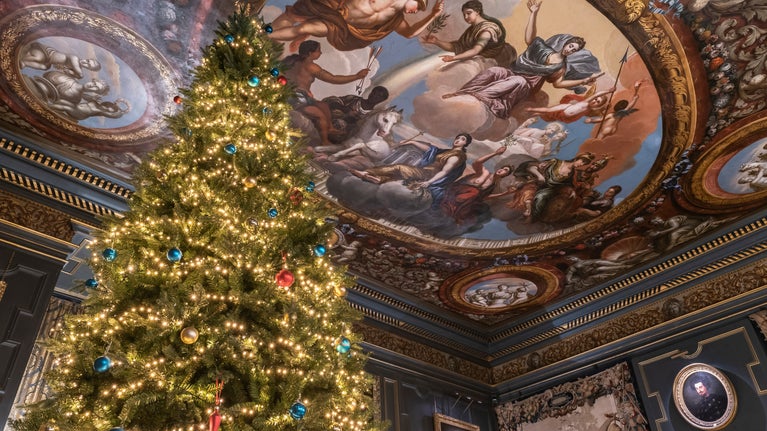
Immerse yourself in history
Meet people from the centuries gone by, learn about the unique artworks in our care and understand more about historic traditions.

We all have festive traditions at Christmas, but have you ever wondered where these customs began? From stirring silver charms into Christmas puddings to kissing boughs, learn more about the ways our Roman, Victorian and medieval ancestors prepared for the season.
The custom of partying in December comes from the Roman festival Saturnalia. Saturn was the Roman God of agriculture and plenty. Wealthy Romans, such as those who lived at Chedworth Roman Villa in Gloucestershire, would've celebrated by playing games as well as eating and drinking lavishly. One game involved throwing dice to decide who should play the part of the Saturnalian monarch.
People decorated homes in the dark winter months, long before Christmas began. At medieval castles servants hung up evergreen boughs and lit fires to brighten up the winter days. Kissing boughs adorned the ceiling, decorated with seasonal fruit. Later people used mistletoe, which was believed to bring good luck and fertility. Even Christmas trees originate from Pagan tree worship and midwinter festivals.
Many Tudor houses like Oxburgh Hall in Norfolk would invite musicians to entertain them during the festive season. Storytelling round the fire appears in many historic accounts of Christmas. In Victorian times, house parties included games like charades or musical chairs. Sometimes a travelling theatre company would set up in the hall of large country houses to perform to the guests.
Dancing has been a central part of Christmas celebrations for centuries. Owners of country houses would engage live musicians to accompany set dances. Charles Paget Wade, former owner of Snowshill, Gloucestershire described the ‘rare adventure of a drive by night in the carriage’ to a Christmas dancing party. Country houses like Lyme Park in Cheshire invited guests to skate when their lakes froze over.

People have over-indulged during midwinter for centuries. In medieval times, no treats or luxuries were allowed during the four weeks before Christmas, and there was a fast on Christmas Eve. You can imagine the relish with which people tucked into their plum porridge, meat and Yule loaves on Christmas Day.
The great table laden every inch is a sparkle of scintillating lights, silver, glass, dishes, tinsel, candles and crackers.
The earliest form of Christmas plum pudding was plum porridge. In the Middle Ages this was made of a shin of beef, stewed with dried fruit. By the 1800s there was a tradition of stirring a sweeter plum pudding on the Sunday before Advent. Children would add silver Christmas charms including coins, a ring to foretell a marriage, a horseshoe for luck and a thimble for a life of blessedness.

In Edwardian times wealthy people would thank staff working in their homes at Christmas. At Lyme Park in Cheshire there would be tea in the servants’ hall followed by a children’s party with gifts like oranges or small toys. Servants might be given clothing, money, a piece of meat or even an umbrella. Sometimes presents were buried in a 'lucky dip' tub full of bran, set next to a Christmas tree.
There are many references to people marking the days of Advent by burning candles or marking the wall with chalk. However, the first printed calendar is credited to Gerhardt Lang in Germany. In the late 19th century his mother taped a sweet to a piece of cardboard for each day of Advent. As an adult Gerhardt set up a printing business and produced his first Advent calendar in 1908 – an idea that soon spread across the world.
Many ancient superstitions surround the Christmas season. A large log of oak too heavy for one man to lift would be put on the hearth in Victorian houses like Tyntesfield in Somerset. If it was still smouldering on Christmas Day, then it was said that the home would be prosperous for the coming year.
On New Year’s Eve, there was a tradition of opening every door and window just before midnight, to let out the ‘burden’ of the old year.

Meet people from the centuries gone by, learn about the unique artworks in our care and understand more about historic traditions.
Whether you’re looking for a relaxing activity or a festive way to bring the family together, follow our step-by-step guide to create a Christmas wreath.

Get into the Christmas spirit with our Advent calendar of 24 festive objects from the collections in our care. Find out what today's object is and delve into the origins of the Advent calendar.

From classic puddings to indulgent treats and savoury festive showstoppers, take a look at some Christmas recipes from our chefs and local experts.

Christmas carols are at the very heart of festive tradition. Many of the texts, tunes and conventions of today’s carols owe more to 19th and early 20th-century taste than they do to the medieval period.
